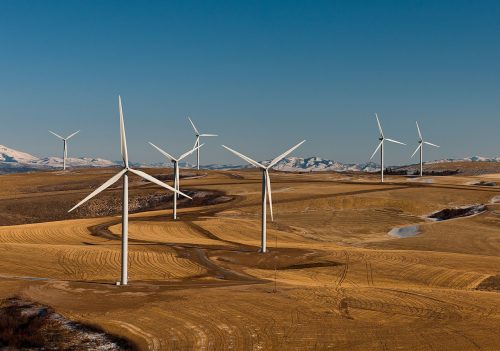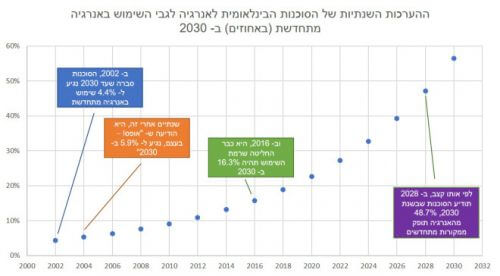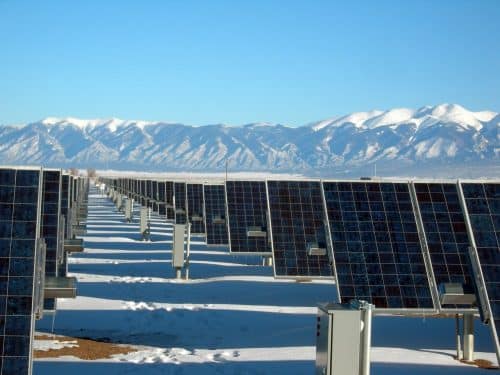A researcher who examined the accuracy of the International Energy Agency's forecasts regarding renewable energy, found that the agency is wrong, time after time, in estimating the level of use of renewable energy

Something strange is happening in the cellars of the International Energy Agency.
Every year the agency releases a report on the state of energy in the world: how much energy is produced from renewable sources, how much from fossil fuels, etc. What else? Strategy researcher Paul Mainwood went through all the reports from the last twenty years, and examined the accuracy of the agency's forecasts regarding renewable energy. It turns out that the agency is wrong, time after time, in estimating the level of use of renewable energy[1].
Mainwood included several graphs in his original assessment, but they're a bit complex, so I've taken his results and pasted them into my own graph: the agency's 2030 projections for renewable energy use (solar and wind only, in percentages).

You see here the agency's estimates every two years, regarding the use of renewable energy. Two interesting things about these estimates:
- The agency is always wrong...down. Every year she gives a low estimate, and only two years later she realizes that the world of technology has advanced, that it is easier to harvest solar energy and wind energy, and she corrects accordingly. If in 2002 it determined that only 4.4% of energy would be produced from renewable sources in 2030, then two years later it already revised its estimate to 5.9%. and two years later, to 6.7%. And after another two years, to 8.7%, and so on. You got the point. Time after time she is wrong, time after time she continues to be wrong.
- The second interesting thing is the rate of change in error. When we look at all the points between 2002 and 2016 (the year Mainewood conducted the review), we find that the jump every two years is fairly consistent, andAbout On the order of twenty percent each time. So we can produce a forecast, according to which in 2018 the agency will release a new report, in which it will state that in 2030 the percentage of renewable energy use will reach 19%. And in 2020 she predicts that the percentage of use in 2030 will be 22.7%. And so on and so forth, until in 2028 the agency determines that in 2030 the percentage of use of renewable energies will reach 48.7 percent.
This is, of course, just a nice little game with data designed to make us think and understand how much the estimates of the International Energy Agency - a professional and reliable body, it is important to note - do not correlate with what is happening on the ground.
To understand why, one can simply examine the technologies for coal mining and oil pumping. When more advanced technologies are developed in the field, it is still necessary to bring them to the destination (usually in other countries), establish the new and cumbersome infrastructure, build a transportation system for oil and coal to the destination, sign international contracts and agreements, and many more complications. As a result, the International Energy Agency is used to the slow rate of improvement in fossil fuel production.
But what happens with renewable energy harvesting technologies?
In general, sunlight is a resource that exists everywhere. This means that more efficient technologies also allow us to harvest it everywhere. As soon as they appear, they are immediately used in every country that enjoys a lot of sunlight, through the establishment of solar power plants. And not only that, but these technologies benefit more from the development of other fields, such as Artificial intelligence that controls the solar panels and directs them so that they follow the sun[2], Or Robots cleaned the solar panels Every day[3].

Even given such developments, it is difficult to see how fifty percent of the existing energy in the world will be produced from solar power plants and wind turbines. The answer is that the truly big leap forward in renewable energy will occur when full decentralization (ie, efficient distribution of solar panels and wind turbines) in energy harvesting becomes possible. In this future, every person will be able to walk with a backpack with solar panels on it, or drive a car with solar panels on the roof. Each building will be covered with cheap solar panels and wind turbines that will generate energy, alongside batteries that will store it for future use, or divert it for immediate use in other parts of the city that do not benefit from wind or sunlight at this very moment.
Such a future sounds imaginary but it is certainly possible, if we only assume that the cost of creating and installing new solar panels will continue to decrease at the same rate. And here comes the leap of faith required in any attempt to predict the future in the long term: we have to believe that the required technologies will indeed be developed.
If we rely on the accumulated mistakes of the most trusted body in the energy market, it seems that these technologies have indeed lived up to the trust we place in them, at least for the last twenty years. Will they continue to improve in the next decade at the same rate? I believe so, but now we just have to wait for the future to find out.
See more on the subject on the science website:
- Coal records
- Clean energy, now cheap
- A new development is gaining momentum: transparent solar panels
- River estuaries as a source of electricity generation
You are invited to read more about my ideas about the future of energy, transportation and governance in my new book "who control the future", in the selected bookstores (and those that are just fine).
[1] https://www.quora.com/profile/Paul-Mainwood/Flotsam/A-modest-proposal-to-the-International-Energy-Authority
[2] https://www.solarpowerworldonline.com/2017/12/will-artificial-intelligence-change-solar-industry/
[3] https://newatlas.com/scrobby-solar-photovoltaic-panel-cleaning-robot/33819/

6 תגובות
I would like to argue against the phrase "energy harvesting". I understand that this is a post-modernist expression for a flop, which claims to replace the old and anachronistic expression: "Energy production". It is not clear why gas, oil and water energy - producers, while wind or solar energy - harvesters? Indeed, even the simple language requires constant changes and developments, whether necessary or not. Just like the scientific-technological developments themselves.
The writer, in his argumentation (to explain SBA's prediction errors) is wrong himself in the same mistake he attributes to SBA. The error attributed to the SBA is that its predictions are an extrapolation based on current technologies. SBA does not take into account future technological development in its forecasts. And what does Dr.Roey Tsezana offer us in his article? His proposal is to "believe" (yes, yes, it's not a mistake, "to believe") that the rate of technological development in harvesting renewable energy will continue at the same rate as we have in the last 20-30 years. In its forecasts, SBA assumes that the current harvesting capacity of renewable energy will be maintained, the author assumes that the current rate of development will be maintained, it is clear that this assumption of the author can later turn out to be wrong. Because as we know - A]. Nothing is conserved (remember? the second law of thermodynamics) b]. It's a little hard to predict the future.
What was the agency's forecast in 2002 for the scope of use in 2018?
Downward biased forecast? Upwards?
Do not trust any government-sponsored "scientific" forecast.
Just look at the official report of the NIST institute about the "disaster" of the twins...
Girl, sober up.
This is not a forecast for different years that should indeed have ups and downs. This is a forecast for that year, and it is always biased downward.
There is no bluff here, on the contrary, the downward trend has helped the deniers make a false claim as if alternative energy is not yet mature enough to replace fossil fuels.
If it is possible to predict with impressive accuracy what the agency is thinking in the future, there is a situation that the agency is simply baffling, have you thought about that?
There is no such thing as a consistent rise up, there are always ups and downs... and the agency painted it as a continuous upward line with a constant slope, what is going on here?